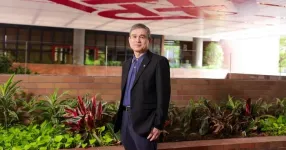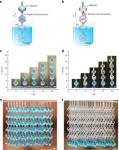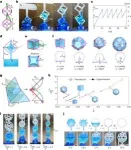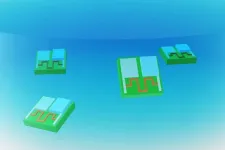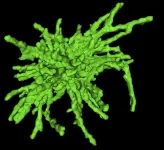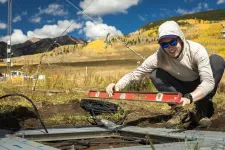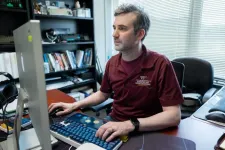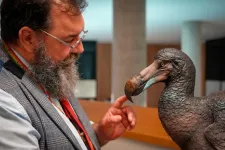(Press-News.org) Society relies heavily on diverse fluidic technologies. The ability toprecisely capture and release various chemical and biological fluids plays a fundamental role in many fields.A long-standing challenge is to design a platform that enables the switchable capture and release of liquids with precise spatial and temporal control and accurate volumes of the fluid. Recently, researchers at The Polytechnic University of Hong Kong (PolyU) have invented a new method to effectively overcome this challenge.
Led by Prof. WANG Liqiu, Otto Poon Charitable Foundation Professor in Smart and Sustainable Energy, Chair Professor of Thermal-Fluid and Energy Engineering, of the PolyU Department of Mechanical Engineering, the research team has developed a unique fluidic processor, “Connected Polyhedral Frames” (CPFs). With CPFs, switching between liquid capture and release becomesreversible, programmable and independent of used polyhedral frames and processed liquids, making the processor a meta-metamaterial.This research has recently been published in Nature Chemical Engineering, with Dr ZHANG Yiyuan, Research Assistant Professor of the Department of Mechanical Engineering, as the first author.
Unlike in the highly developed area of solids manipulation, convenient handling of fluids remains a cumbersome task despite the ubiquity of fluids in, for example, the healthcare, pharmaceutical, biological and chemical industries. As fluids interact with tools, they frequently wet and spread on the solids, preventing complete liquid transfer, impairing volumetric accuracy and causing inter-sample cross contamination. To preserve the purity of fluids, disposable plastics such as pipettes and microtubes are widely used, adding to the global problem of plastic waste.
Reversible switching between capture and release is the key to CPFs’ capability to precisely process liquids, enabling the liquid in the network to be retained or drained locally, dynamically and reversibly as desired. In the CPFs, frames above the single-rod connection without a pathway for liquid drainage between frames, capture and retain liquids, thus functioning as capturers. While the frames above the double-rod connection imbibe but release liquids, serving as releasers. This is because when the CPFs are lifted from the liquid, a liquid film forms between the double-rod connections, creating channels between frames that facilitate liquid release.
Reversible switching between capture and release can be achieved, using available tools, by constructing or breaking the liquid continuity between frames. CPFs offer a versatile platform that enables many unique functions including 3D programmable patterning of liquids, 3D spatiotemporal control of concentrations of multiple materials, packaging of 3D liquid arrays and large-scale manipulation of multiple liquids. It is compatible with a broad range of liquids, including but not limited to aqueous solutions, biofluids, hydrogels, organic solvents, polymer solutions and oils. Therefore, a variety of biomaterials and chemicals can be incorporated into CPFs for various applications.
To demonstrate the practical utility of CPFs in controlled multidrug release, Prof. Wang’s team designed a CPF network for the 3D binary liquid patterning of vitamins B2 and B12. The two vitamins, representing two different types of drug molecules, were encapsulated in sodium alginate hydrogel and gellan gum, respectively, and released in aqueous solution. By altering the thickness of the gel membrane, the relative release rates of the two “drugs” can be precisely controlled.
Traditional cotton swabs and flocking swabs suffer from severe sample residues during their sample release. CPFs can effectively overcome this challenge because their frame structure renders free liquid-liquid interfaces for high release efficiency. Using the influenza virus as an example, the research team demonstrated the superiority of CPFs as sampling tools with much better release performance. When the virus concentration was low, the CPFs detected the virus, while both the flocking swab and cotton swab failed to do so.
The team has also demonstrated the application of CPFs in biomaterial encapsulation. Taking Acetobacterium encapsulation as an example, the CPFs show many advantages over traditional devices, including by facilitating the separation of bacteria and reaction products, simplifying the microbial reaction process and enhancing the utilisation rate of bacteria. It is conceivable that CPF could also be applied to encapsulate other biological materials for efficient production of other valuable products.
In addition to medical and microbial applications, Prof. Wang’s team has further demonstrated the practicability of CPFsfor air conditioning. They prepared a commercial-scale humidifierprototype, which has a higher water storage capacity and requires less water flow, making them potentially more energy efficient.The CPFs also allow large-scale 3D liquid dispersionto form a larger surface area, making them very useful for gas absorption. An ideal CO2 cycle process is successfully generated with CPFs, which includes carbon capture and storage and CO2 reutilisation.
Importantly, each frame in CPFs captures or releases liquids independent of its base materials, structures and handled liquids, being thus an innovative meta-metamaterial that makes the dream of “precisely scooping water with a bamboo basket” come true. The availability of such a fluidic processor sets a new standard for handling liquids with controllability, versatility and high performance, inspires a new field of meta-metamaterials, and facilitates new scientific and technological breakthroughs in various fields.
END
PolyU develops versatile fluidic platform for programmable liquid processing
2024-08-16
ELSE PRESS RELEASES FROM THIS DATE:
MIT engineers design tiny batteries for powering cell-sized robots
2024-08-16
A tiny battery designed by MIT engineers could enable the deployment of cell-sized, autonomous robots for drug delivery within in the human body, as well as other applications such as locating leaks in gas pipelines.
The new battery, which is 0.1 millimeters long and 0.002 millimeters thick — roughly the thickness of a human hair — can capture oxygen from air and use it to oxidize zinc, creating a current of up to 1 volt. That is enough to power a small circuit, sensor, or actuator, the researchers showed.
“We think this is going to be very enabling ...
New tool simplifies cell tracking data analysis
2024-08-16
Studying cell migration is vital because it plays a crucial role in many biological processes, including immune response, wound healing, and cancer metastasis. Understanding how cells move and behave can lead to breakthroughs in treating diseases, developing new drugs, and creating innovative therapies. For example, in cancer research, tracking how cancer cells migrate can reveal how tumors grow and spread through the human body. This insight can led to the discovery of more efficient and targeted treatments to stop or even prevent metastasis.
Scientists have introduced CellTracksColab, a tool that simplifies cell tracking data analysis. This free platform leverages advanced ...
Exploring Huntington’s disease, researchers discover that protein aggregates poke holes in nuclear membrane
2024-08-16
Researchers at Utrecht University in the Netherlands have identified a new way in which the toxic protein aggregates associated with Huntington’s disease may damage nerve cells and cause them to die. The study, to be published August 16 in the Journal of Cell Biology (JCB), suggests that the aggregates can poke holes in the membrane that separates the nucleus from the rest of the cell, damaging the DNA inside the nucleus and changing the activity of neuronal genes.
Huntington’s disease is a devastating neurogenerative disorder caused by a mutation in the HTT gene that results in cells producing abnormally large versions of the huntingtin protein. These ...
Why isn't Colorado's snowpack ending up in the Colorado River? New research suggests the problem might be the lack of spring rainfall
2024-08-16
The Colorado River and its tributaries provide water for hydropower, irrigation and drinking water in seven U.S. states and Mexico. Much of this water comes from the snowpack that builds up over the winter and then melts each spring. Every year in early April, water managers use the snowpack to predict how much water will be available for the upcoming year.
But since 2000, these predictions have been incorrect, with the actual streamflow being consistently lower than the predicted streamflow. That’s left water managers ...
New research shows unprecedented atmospheric changes during May's geomagnetic superstorm
2024-08-16
On May 11, a gorgeous aurora surprised stargazers across the southern United States. That same weekend, a tractor guided by GPS missed its mark.
What do the visibility of the northern lights have in common with compromised farming equipment in the Midwest?
A uniquely powerful geomagnetic storm, according to two newly published papers co-authored by Virginia Tech's Scott England.
“The northern lights are caused by energetic, charged particles hitting our upper atmosphere, which are impacted by numerous factors in space, including the sun,” said England, associate professor in the Kevin T. Crofton Department of Aerospace and Ocean Engineering. “During ...
How some states help residents avoid costly debt during hard times
2024-08-16
COLUMBUS, Ohio – A new national study provides the best evidence to date that generous unemployment insurance benefits during the COVID-19 pandemic helped reduce reliance on high-cost credit use.
Researchers found that lower-income residents of states with more generous benefits were significantly less likely than those living in less-generous states to take out new credit cards, personal finance loans and payday loans or other alternative financial service offerings.
The study, published recently in the journal ...
Same person. Different place. Twice the odds of a dementia diagnosis.
2024-08-16
With new medications on the market or in the works for Alzheimer’s disease and other kinds of dementia, a new study suggests that getting the diagnosis needed to access these new treatments may depend on where you live.
The percentage of people who get a new dementia diagnosis each year varies a lot across regions of the U.S., the study finds.
And the differences between regions of the country are even larger for people on the young end of the dementia-risk age range, ages 66 to 74, and for those who are Black ...
The banana apocalypse is near, but UMass Amherst biologists might have found a key to their survival
2024-08-16
August 16, 2024
The Banana Apocalypse is Near, but UMass Amherst Biologists Might Have Found a Key to Their Survival
Discovery of molecular mechanisms used by the banana-destroying microbe brings hope to the breakfast table
AMHERST, Mass. – The bananas in your supermarket and that you eat for breakfast are facing functional extinction due to the disease Fusarium wilt of banana (FWB) caused by a fungal pathogen called Fusarium oxysporum f.sp. cubense (Foc) tropical race 4 (TR4). However, thanks to recent research from an ...
Rethinking the dodo
2024-08-16
Rethinking the Dodo
Review of 400 years of scientific literature corrects the record on icon of extinction
Researchers are setting out to challenge our misconceptions about the Dodo, one of the most well-known but poorly understood species of bird.
In a paper published today [16 August 2024] in the Zoological Journal of the Linnean Society researchers from the University of Southampton, Natural History Museum (NHM) and Oxford University Museum of Natural History have undertaken the most comprehensive review of the taxonomy of the Dodo and its closest relative, the Rodriguez ...
Arts and crafts improves your mental health as much as having a job, scientists find
2024-08-16
Could arts and crafts help protect the public’s mental health? A new study in Frontiers in Public Health provides evidence that indulging our creative side could provide everyone with a significant wellbeing boost. Because arts and crafts are relatively affordable and accessible, promoting the public’s access to artistic activities could provide a major boost to public mental health.
“Crafting and other artistic activities showed a meaningful effect in predicting people’s ...
